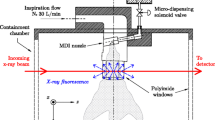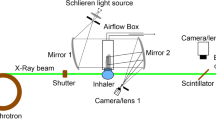Abstract
Purpose
Typical methods to study pMDI sprays employ particle sizing or visible light diagnostics, which suffer in regions of high spray density. X-ray techniques can be applied to pharmaceutical sprays to obtain information unattainable by conventional particle sizing and light-based techniques.
Methods
We present a technique for obtaining quantitative measurements of spray density in pMDI sprays. A monochromatic focused X-ray beam was used to perform quantitative radiography measurements in the near-nozzle region and plume of HFA-propelled sprays.
Results
Measurements were obtained with a temporal resolution of 0.184 ms and spatial resolution of 5 μm. Steady flow conditions were reached after around 30 ms for the formulations examined with the spray device used. Spray evolution was affected by the inclusion of ethanol in the formulation and unaffected by the inclusion of 0.1% drug by weight. Estimation of the nozzle exit density showed that vapour is likely to dominate the flow leaving the inhaler nozzle during steady flow.
Conclusions
Quantitative measurements in pMDI sprays allow the determination of nozzle exit conditions that are difficult to obtain experimentally by other means. Measurements of these nozzle exit conditions can improve understanding of the atomization mechanisms responsible for pMDI spray droplet and particle formation.







Similar content being viewed by others
Abbreviations
- EMI:
-
Electronic metering inhaler
- EtOH:
-
Ethanol
- HFA:
-
Hydrofluoroalkane
- IPBr:
-
Ipratropium bromide
- PDA:
-
Phase doppler anemometry
- pMDI:
-
Pressurised metered-dose inhaler
- SLPM:
-
Standard litres per minute
References
Gupta A, Stein SW, Myrdal PB. Balancing ethanol cosolvent concentration with product performance in 134a-based pressurized metered dose inhalers. J Aerosol Med. 2003;16(2):167–74.
Dhand R. Aerosol plumes: slow and steady wins the race. J Aerosol Med. 2005;18(3):261–3.
Dunbar C. An experimental and theoretical investigation of the spray issued from a pressurised metered-dose inhaler. Manchester: University of Manchester; 1996.
Ju D, Shrimpton J, Hearn A. The effect of reduction of propellant mass fraction on the injection profile of metered dose inhalers. Int J Pharm. 2010;391(1):221–9.
Stein SW. Size distribution measurements of metered dose inhalers using Andersen Mark II cascade impactors. Int J Pharm. 1999;186(1):43–52.
Stein SW, Myrdal PB. A theoretical and experimental analysis of formulation and device parameters affecting solution MDI size distributions. J Pharm Sci. 2004;93(8):2158–75.
Stein SW, Myrdal PB. The relative influence of atomization and evaporation on metered dose inhaler drug delivery efficiency. Aerosol Sci Technol. 2006;40(5):335–47.
Stein SW. Aiming for a moving target: challenges with impactor measurements of MDI aerosols. Int J Pharm. 2008;355(1):53–61.
Dunbar C, Watkins A, Miller J. An experimental investigation of the spray issued from a pMDI using laser diagnostic techniques. J Aerosol Med. 1997;10(4):351–68.
Wigley G, Versteeg H, Hodson D. Near-orifice PDA measurements and atomisation mechanism of a pharmaceutical pressurised metered dose inhaler. In: 18th Annual Conference on Liquid Atomization & Spray Systems. Zaragoza, Spain: Institute for Liquid Atomization & Spray Systems. 2002. .
Buchmann NA, Duke DJ, Shakiba SA, Mitchell DM, Stewart PJ, Traini D, et al. A novel high-speed imaging technique to predict the macroscopic spray characteristics of solution based pressurised metered dose inhalers. Pharm Res. 2014;31(11):2963–74.
Kastengren AL, Tilocco FZ, Duke DJ, Powell CF, Zhang X, Moon S. Time-resolved X-ray radiography of sprays from engine combustion network spray A diesel injectors. Atomization Sprays. 2014;24(3);251–72.
Duke DJ, Kastengren AL, Tilocco FZ, Swantek AB, Powell CF. X-ray radiography measurements of cavitating nozzle flow. Atomization Sprays. 2013;23(9).
Kastengren A, Powell CF, Arms D, Dufresne EM, Gibson H, Wang J. The 7BM beamline at the APS: a facility for time-resolved fluid dynamics measurements. J Synchrotron Radiat. 2012;19(4):654–7.
Als-Nielsen J, McMorrow D. Elements of modern X-ray physics. Chichester: John Wiley & Sons; 2011.
Kastengren A, Powell CF. Synchrotron X-ray techniques for fluid dynamics. Exp Fluids. 2014;55(3):1–15.
Saloman E, Hubbell J, Scofield J. X-ray attenuation cross sections for energies 100 eV to 100 keV and elements Z= 1 to Z= 92. At Data Nucl Data Tables. 1988;38(1):1–196.
Tillner-Roth R, Baehr HD. An international standard formulation for the thermodynamic properties of 1, 1, 1, 2-Tetrafluoroethane (HFC-134a) for temperatures from 170 K to 455 K and pressures up to 70 MPa. J Phys Chem Ref Data. 1994;23(5):657–729.
Huber ML, Laesecke A, Perkins RA. Model for the viscosity and thermal conductivity of refrigerants, including a new correlation for the viscosity of R134a. Ind Eng Chem Res. 2003;42(13):3163–78.
Span R, Lemmon EW, Jacobsen RT, Wagner W, Yokozeki A. A reference equation of state for the thermodynamic properties of nitrogen for temperatures from 63.151 to 1000 K and pressures to 2200 MPa. J Phys Chem Ref Data. 2000;29(6):1361–433.
Tegeler C, Span R, Wagner W. A new equation of state for argon covering the fluid region for temperatures from the melting line to 700 K at pressures up to 1000 MPa. J Phys Chem Ref Data. 1999;28(3):779–850.
Majer V, Svoboda V, Kehiaian HV. Enthalpies of vaporization of organic compounds: a critical review and data compilation. vol. 32. Oxford: Blackwell Scientific; 1985.
Ambrose D, Sprake C. Thermodynamic properties of organic oxygen compounds XXV. Vapour pressures and normal boiling temperatures of aliphatic alcohols. J Chem Thermodyn. 1970;2(5):631–45.
Khattab IS, Bandarkar F, Fakhree MAA, Jouyban A. Density, viscosity, and surface tension of water+ ethanol mixtures from 293 to 323 K. Korean J Chem Eng. 2012;29(6):812–7.
Lewis DA. Method and system for electronic MDI model. Google Patents; 2013. WO Patent App. PCT/EP2012/074,278. Available from: http://www.google.com/patents/WO2013083530A2?cl=en.
Clark AR. Metered atomisation for respiratory drug delivery. Loughborough University of Technology. 1991.
Gabrio BJ, Stein SW, Velasquez DJ. A new method to evaluate plume characteristics of hydrofluoroalkane and chlorofluorocarbon metered dose inhalers. Int J Pharm. 1999;186(1):3–12.
Van Cruyningen I, Lozano A, Hanson R. Quantitative imaging of concentration by planar laser-induced fluorescence. Exp Fluids. 1990;10(1):41–9.
Kastengren A, Powell CF, Dufresne EM, Walko DA. Application of X-ray fluorescence to turbulent mixing. J Synchrotron Radiat. 2011;18(5):811–5.
Duke DJ, Kastengren AL, Mason-Smith N, Chen Y, Young PM, Traini D, et al. Temporally and spatially resolved x-ray fluorescence measurements of in-situ drug concentration in metered-dose inhaler sprays. Pharm Res. 2015.
Kastengren AL, Powell CF, Cheong SK, Wang Y, Im KS, Liu X, et al. Determination of diesel spray axial velocity using X-ray radiography. SAE Trans. 2007-01-0666. 2007.
Cossali G. An integral model for gas entrainment into full cone sprays. J Fluid Mech. 2001;439:353–66.
Duke D, Swantek A, Tilocco Z, Kastengren A, Fezzaa K, Neroorkar K, et al. X-ray imaging of cavitation in diesel injectors. SAE Trans. 2014.
ACKNOWLEDGMENTS AND DISCLOSURES
The authors gratefully acknowledge the support given to the project by the Australian Research Council. The authors wish to thank Dr. Chris Powell and Dr. Andrew Swantek, Energy Systems Division, Argonne National Laboratory. This research was performed at the 7-BM beamline of the Advanced Photon Source at Argonne National Laboratory. Use of the APS is supported by the U.S. Department of Energy (DOE) under Contract No. DE-AC02-06CH11357. The submitted manuscript has been created by UChicago Argonne, LLC, Operator of Argonne National Laboratory (“Argonne”). Argonne, a U.S. Department of Energy Office of Science laboratory, is operated under Contract No. DEAC02-06CH11357. The U.S. Government retains for itself, and others acting on its behalf, a paid-up nonexclusive, irrevocable worldwide license in said article to reproduce, prepare derivative works, distribute copies to the public, and perform publicly and display publicly, by or on behalf of the Government.
Author information
Authors and Affiliations
Corresponding author
Rights and permissions
About this article
Cite this article
Mason-Smith, N., Duke, D.J., Kastengren, A.L. et al. Insights into Spray Development from Metered-Dose Inhalers Through Quantitative X-ray Radiography. Pharm Res 33, 1249–1258 (2016). https://doi.org/10.1007/s11095-016-1869-5
Received:
Accepted:
Published:
Issue Date:
DOI: https://doi.org/10.1007/s11095-016-1869-5




